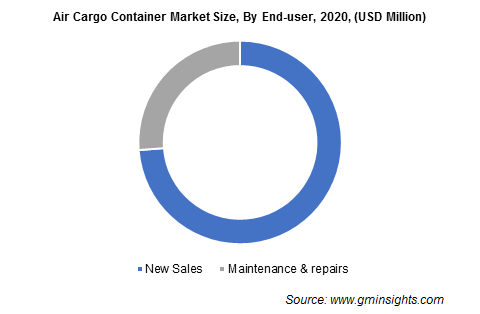Home > Aerospace & Defense > Airport Operations > Airport Infrastructure > Air Cargo Container Market
Air Cargo Container Market Analysis
- Report ID: GMI3050
- Published Date: Feb 2021
- Report Format: PDF
Air Cargo Container Market Analysis
Air cargo container market from freighter aircraft generated around USD 700 million in 2020 propelled by its extensive use in transporting air cargo. The increasing preference toward online shopping and the presence of a large number of manufacturing facilities of electronic products & other commercial goods in countries, such as Vietnam, Thailand, China, Japan, Taiwan, and India, are boosting the air cargo market. Airlines including SpiceJet, Garuda Indonesia, and ANA Cargo are likely to deploy more freighter aircraft, driving demand through 2027.
Refrigerated container segment is projected to register growth rate of above 4.2% CAGR till 2027. The global pharmaceutical market is the most specialized, regulated, and fragile cargo market to handle in the world today. Temperature-controlled pharmaceutical and biological products require refrigerated containers, which can maintain temperature in the range of 2oC to 8oC or well below 0oC depending on the pharmaceutical product to be transported. According to IATA, the total airline cargo revenue for pharmaceutical products exceeded USD 1.4 billion in 2018 and is estimated to grow further owing to its ability to transport products in short duration as well as preserving and maintaining the fragile cargo.
Metal material is predicted to capture more than 80% of the air cargo container market share by 2027. ULD containers are generally manufactured from aluminum or steel based on the requirements. Aluminum is generally preferred due to its lightweight properties and corrosion-free nature. Air cargo container comprises aluminum extrusions, relatively thick base sheet, and aluminum side and roof panels.
In 2020, the main deck segment accounted for majority of the market share. The major portion of the cargo is generally carried on the main deck, which is also known as upper deck of an aircraft. The cargo freighter airplane has its entire main deck equipped for upper deck type of containers while Combi aircraft utilizes its rear part of the main deck for cargo loading.
The new sales segment is forecast to witness around 4% CAGR through 2027. China’s commercial aircraft fleet has increased sevenfold and accounted for above 25% of all aviation growth globally in the last decade. China’s airlines are poised to acquire about 8,600 new aircraft, which will be valued at USD 1.4 trillion coupled with services valued more than USD 1.7 trillion over the next 20 years. Such trends will encourage sales of new air cargo container in the aviation sector during 2021 to 2027.

Europe air cargo container market size is set to expand at 3.5% CAGR during 2021 to 2027. Various factors, such as growth of the e-commerce sector and increased focus on adoption of temperature-sensitive products, are expected to drive the market development in European countries. Additionally, the growth of the consumer electronics industry is supporting air cargo market growth through 2027. The growing popularity of certified containers in this region is likely to drive the market growth rate. European Aviation Safety Agency (EASA) is a regulating body that provides guidelines for air cargo transportation to maintain airworthiness of the product.

